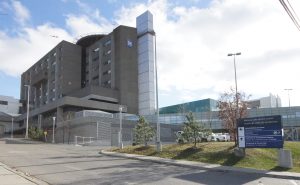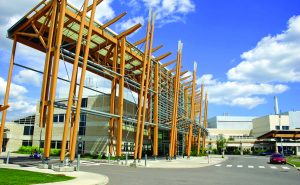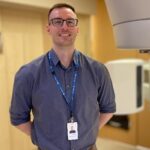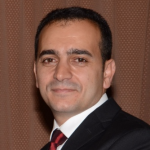Medical Physics Residency
Primarily working in hospital cancer care centres, medical physicists have specialized education in the application of physics to health care. NOSM University works in collaboration with Health Sciences North and the Thunder Bay Regional Health Sciences Centre to provide the Medical Physics Residency Education Program (MPREP), which offers education in the clinical application of medical physics with a particular focus on radiation oncology. Learners in this program learn how to apply physics to the processes that constitute a radiation treatment program, including development of individualized patient radiation treatment plans, computation of radiation doses, verification of the accuracy of radiation treatments, maintenance of a comprehensive quality assurance program, and ensuring appropriate radiation safety in facility design and equipment operation, and compliance with applicable regulatory requirements.
About the Program
The radiation treatment centres are operated by two Northern academic teaching hospitals: Health Sciences North (HSN) in Sudbury and in Thunder Bay, the Thunder Bay Regional Health Sciences Centre (TBRHSC). Although during the course of the program residents are formal full-time employees of one or the other of these two hospitals, they will be required to fulfill the same requirements using the resources of both sites in accordance with the NOSM University model. They are expected to enhance their learning experience with contributions to the clinical work in a manner corresponding to the progression of their level of training. Successful completion of the residency requires that residents are fully competent in that they have met all educational standards and are capable of working with minimal supervision in a radiation treatment facility, have passed a formal oral examination administered by the Program, and are fully eligible to apply for clinical certification by the Canadian College of Physicists in Medicine (CCPM).
About Medical Physics
Developments in Physics have had significant consequences well beyond the conventional boundaries of the discipline, including in Medicine. The pivotal moment when a revolutionary impact upon medicine began is most likely the discovery of x-rays by Wilhelm Roentgen in 1895, a fortuitous event that resulted in his receipt of the first Nobel Prize in Physics in 1901. This discovery rapidly led to techniques and technological advancements for use in diagnosis and treatment that are fundamental to the practice of medicine today. And the revolution is far from over. Discoveries and innovations continue to improve the quality of care available to patients worldwide. The overall impact has been such that Medical Physics is now recognized as a field unto itself.
In Canada there are two organizations representing the professional interests of Medical Physicists: the Canadian Organization of Medical Physicists (COMP) and the Canadian College for Physicists in Medicine (CCPM).
COMP is the main professional body representing medical physicists practicing in Canada. The Mission of COMP is to promote and advance the Canadian medical physics community’s integral role in healthcare by supporting research, education, innovation and excellence in professional practice.
Members of COMP include not only medical physicists working in the clinical environment, but also those employed in academia, industry, and government. These positions are public and/or private sector, and range in focus from teaching and research to administrative and regulatory roles through to a myriad of commercial interests.
The CCPM, on the other hand, is a certifying body for Medical Physicists who wish to work in the clinical environment, which is a distinct subset of the discipline. The mission of the CCPM is to serve the public by identifying through certification individuals who have acquired, demonstrated, and maintained a requisite standard of knowledge, skill and, understanding essential to the clinical practice of medical physics. Certification is sought by hospitals and other treatment facilities that hire medical physicists who have direct impact upon delivery of clinical care. Certification of competence is offered in four distinct sub-specialties: Diagnostic Radiological Physics, Magnetic Resonance Imaging, Nuclear Medicine Physics, and Radiation Oncology Physics.
In order to become a CCPM certified Medical Physicist in Canada, individuals must successfully complete the Membership Examination for a specific sub-discipline, such as Radiation Oncology. A prerequisite is that an applicant has successfully completed a CAMPEP accredited medical physics residency. Note that admission into the residency program also has a number of prerequisites that must be met by applicants. The role of MPREP is to provide accredited residency training for individuals interested in certifying in the sub-specialty of Radiation Oncology Physics. “Oncology” is the study of tumours, and “Radiation Oncology” is the treatment of tumours with radiation. In essence, the certification recognizes the competency of individuals to participate in the radiation treatment of cancer.
Program Structure
The program is academically administered by a collaborative involving the two academic teaching hospitals, Health Sciences North (Sudbury) and the Thunder Bay Regional Health Sciences Centre (Thunder Bay), and NOSM University (which has facilities in both Sudbury and Thunder Bay and across Northern Ontario). The qualified clinical medical physicists, appointed to the program as NOSM University faculty, are members of the Division of Medical Sciences and the medical physics residents are “learners” of the collaborative. The faculty and resident body use NOSM University technology and academic administrative infrastructure to plan, communicate, and coordinate activities. To provide an overview, the current program structure is presented schematically.
The program requires that residents are integrated into the clinical activities of a cancer center so that they are engaged in both academic and structured practical training. While such integration of the two residents is primarily at their respective designated site, there is also engagement with the health care teams of both cancer centres. An important component is routine interaction of the residents and faculty of both campuses during regularly scheduled videoconferences or teleconferences, which are held on a nominal weekly basis. Such sessions are topic focused and used for purposes such as enabling participation by those of the alternate campus in presentations being given by a resident or MPREP faculty.
The program is structured to be completed within a minimum period of 24 months (two years). The first two weeks of the residency consists of an orientation introducing new residents to all aspects of the work environment and the training program. During the orientation the resident is introduced to the Program Director and a most responsible medical physicist faculty member is identified for each of the Clinical Rotations and Learning Modules that constitute the formal components of the program. Regardless of assignment, all teaching faculty members, clinical physicists, and staff aligned with the program provide mentoring, teaching, and learning support in addition to, as appropriate, educational oversight.
Subsequent to the orientation, the resident will commence working through the series of pre-established Clinical Rotations and Learning Modules. Each rotation and module has detailed requirements that must be satisfied and an assigned medical physicist faculty member to act as clinical instructor and/or coordinator.
To provide an idea of how all this would be accomplished in two years, have a quick look at a sample schedule for a typical resident.
Education and Training Facilities
MPREP has the full support of NOSM University and its campus educational facilities. The dual site infrastructure (Sudbury and Thunder Bay campuses) is available to the program and residents. Such infrastructure includes health sciences library services, teleconferencing and videoconferencing facilities, program administrative services, and a web based platform for document management and performance tracking. In addition, residents are able to avail themselves of the resources of the two fully operational clinical cancer centres.
 The Regional Cancer Program at Health Sciences North is an outpatient and research facility providing cancer services for Northeastern Ontario. The radiation treatment program treats approximately 2,000 patients per year. In April 2011, the Regional Cancer Program opened a single linac radiation treatment facility located at the Sault Area Hospital in Sault Ste. Marie. The Regional Cancer Program at the HSN has six medical linear accelerators (2 Varian Clinac iX, 2 Varian TrueBeam, 2 Elekta Infinity), a high dose rate brachytherapy unit (Elekta), a radioactive seed implant suite, and two CT simulators (GE Medical Systems). One of the medical linear accelerators (Clinac iX) is located at the Sault Area Hospital. The clinical programs at the Regional Cancer Program include image-guided radiation therapy, intensity modulated radiation therapy, high dose rate and permanent implant brachytherapy. External beam treatment planning is performed with the Pinnacle treatment planning system and the record and verify system is Mosaiq.
The Regional Cancer Program at Health Sciences North is an outpatient and research facility providing cancer services for Northeastern Ontario. The radiation treatment program treats approximately 2,000 patients per year. In April 2011, the Regional Cancer Program opened a single linac radiation treatment facility located at the Sault Area Hospital in Sault Ste. Marie. The Regional Cancer Program at the HSN has six medical linear accelerators (2 Varian Clinac iX, 2 Varian TrueBeam, 2 Elekta Infinity), a high dose rate brachytherapy unit (Elekta), a radioactive seed implant suite, and two CT simulators (GE Medical Systems). One of the medical linear accelerators (Clinac iX) is located at the Sault Area Hospital. The clinical programs at the Regional Cancer Program include image-guided radiation therapy, intensity modulated radiation therapy, high dose rate and permanent implant brachytherapy. External beam treatment planning is performed with the Pinnacle treatment planning system and the record and verify system is Mosaiq.
 Regional Cancer Care Northwest is an outpatient and research facility at the Thunder Bay Regional Health Sciences Centre (TBRHSC) providing cancer services for Northwestern Ontario. The radiation treatment program treats approximately 850 patients per year. Regional Cancer Care Northwest operates two medical linear accelerators (2 Elekta Infinity), a high dose rate brachytherapy unit (Elekta Flexitron), and a large bore CT-simulator (Siemens Somatom). In addition, a PET-CT (Philips Gemini TF) has been configured to function as a backup simulator. Brachytherapy is delivered in an appropriately shielded fully functional operating theatre. Simulation is performed using MonacoSim, treatment planning is performed using Monaco, and record and verify is supported through Mosaiq, all of these systems being Elekta products. Mosaiq is the backbone of the electronic patient record for both Radiation Oncology and Medical Oncology.
Regional Cancer Care Northwest is an outpatient and research facility at the Thunder Bay Regional Health Sciences Centre (TBRHSC) providing cancer services for Northwestern Ontario. The radiation treatment program treats approximately 850 patients per year. Regional Cancer Care Northwest operates two medical linear accelerators (2 Elekta Infinity), a high dose rate brachytherapy unit (Elekta Flexitron), and a large bore CT-simulator (Siemens Somatom). In addition, a PET-CT (Philips Gemini TF) has been configured to function as a backup simulator. Brachytherapy is delivered in an appropriately shielded fully functional operating theatre. Simulation is performed using MonacoSim, treatment planning is performed using Monaco, and record and verify is supported through Mosaiq, all of these systems being Elekta products. Mosaiq is the backbone of the electronic patient record for both Radiation Oncology and Medical Oncology.
Past and Present Medical Physics Residents
CAMPEP first granted accreditation as of December 15, 2016 and since then there have been four graduates and two new incumbents.
Current MPREP Residents:
 Fazal ur-Rehman obtained his Ph.D. in Medical Physics from the CAMPEP accredited graduate program of the University of Manitoba, Winnipeg, Canada. He also holds a M.Sc. and a M. Phil degrees, both in Physics, from Quaid-i-Azam University, Islamabad. After completing his PhD in Medical Physics, he worked as a Research Fellow at the Department of Radiology, University of Manitoba and then as an Assistant Professor in Physics at King Fahd University of Petroleum & Minerals (KFUPM), Dhahran, Saudi Arabia. Recently he has been associated with Medical Physics Department, University of Manitoba, as a continuing graduate student to obtain his remaining CAMPEP Accredited Medical Physics Graduate Program requirements. His graduate work includes the design and development of detector modules for a highly compact and portable preclinical pet system. With his extensive academic career within the field of Medical Physics, he has found that the clinical component is an important aspect for which he has a particular passion. In pursuit of this goal, he enrolled in MPREP.
Fazal ur-Rehman obtained his Ph.D. in Medical Physics from the CAMPEP accredited graduate program of the University of Manitoba, Winnipeg, Canada. He also holds a M.Sc. and a M. Phil degrees, both in Physics, from Quaid-i-Azam University, Islamabad. After completing his PhD in Medical Physics, he worked as a Research Fellow at the Department of Radiology, University of Manitoba and then as an Assistant Professor in Physics at King Fahd University of Petroleum & Minerals (KFUPM), Dhahran, Saudi Arabia. Recently he has been associated with Medical Physics Department, University of Manitoba, as a continuing graduate student to obtain his remaining CAMPEP Accredited Medical Physics Graduate Program requirements. His graduate work includes the design and development of detector modules for a highly compact and portable preclinical pet system. With his extensive academic career within the field of Medical Physics, he has found that the clinical component is an important aspect for which he has a particular passion. In pursuit of this goal, he enrolled in MPREP.
 Robert Bellis holds a M.Sc. in Biomedical Physics (CAMPEP) from Ryerson University, an MBA from the Schulich School of Business at York University, and a BSc. in Radiation Therapy from Laurentian University. His MSc. graduate thesis entailed predicting tumour response with radiomics and machine learning in MR-guided brachytherapy. Robert also possesses extensive clinical experience, having worked within the Windsor Regional Cancer Program as a radiation therapist for 10 years. Upon completion of his residency, Robert plans to work as a clinical medical physicist in Canada.
Robert Bellis holds a M.Sc. in Biomedical Physics (CAMPEP) from Ryerson University, an MBA from the Schulich School of Business at York University, and a BSc. in Radiation Therapy from Laurentian University. His MSc. graduate thesis entailed predicting tumour response with radiomics and machine learning in MR-guided brachytherapy. Robert also possesses extensive clinical experience, having worked within the Windsor Regional Cancer Program as a radiation therapist for 10 years. Upon completion of his residency, Robert plans to work as a clinical medical physicist in Canada.
MPREP Graduates:
 Lalageh Mirzakhanian obtained her Ph.D. in Physics (Medical Physics) from McGill University in 2019. Her research was focused on small field dosimetry with applications in biology-guided radiotherapy and Gamma Knife machines. She also received an M.Sc. in Medical Radiation Physics from McGill University (2015) and an M.Sc. in Applied Nuclear Physics from K. N. Toosi University (2012). Her research interests are radiation physics, dosimetry, Monte Carlo modeling, and ionization chambers. In the future, she plans to contribute to health care as a clinical medical physicist, including advancing research in the field.
Lalageh Mirzakhanian obtained her Ph.D. in Physics (Medical Physics) from McGill University in 2019. Her research was focused on small field dosimetry with applications in biology-guided radiotherapy and Gamma Knife machines. She also received an M.Sc. in Medical Radiation Physics from McGill University (2015) and an M.Sc. in Applied Nuclear Physics from K. N. Toosi University (2012). Her research interests are radiation physics, dosimetry, Monte Carlo modeling, and ionization chambers. In the future, she plans to contribute to health care as a clinical medical physicist, including advancing research in the field.
 Isaac Tavares is a graduate of both Lakehead and Laurentian Universities with degrees in Physics (B.Sc.), Mechanical Engineering (B.Eng.) and Applied Physics (M.Sc.). His graduate research involved modelling radiotherapy equipment and performing Monte Carlo simulations of inhomogeneities within tissue. He is a licenced Professional Engineer (P.Eng.), a Certified Medical Dosimetrist (CMD), and his extensive professional career in the field of radiation treatment includes patient specific and equipment quality assurance, servicing radiotherapy equipment, and generating patient dose distributions (treatment planning) for both external beam and brachytherapy patients.
Isaac Tavares is a graduate of both Lakehead and Laurentian Universities with degrees in Physics (B.Sc.), Mechanical Engineering (B.Eng.) and Applied Physics (M.Sc.). His graduate research involved modelling radiotherapy equipment and performing Monte Carlo simulations of inhomogeneities within tissue. He is a licenced Professional Engineer (P.Eng.), a Certified Medical Dosimetrist (CMD), and his extensive professional career in the field of radiation treatment includes patient specific and equipment quality assurance, servicing radiotherapy equipment, and generating patient dose distributions (treatment planning) for both external beam and brachytherapy patients.
 Daniel S. Cho (MCCPM) holds a Ph.D. in Systems Design Engineering from University of Waterloo, a M.E.Sc. in biomedical engineering at University of Western Ontario, and a B.Sc. in Biomedical Computing from Queen’s University. He also completed the CAMPEP-accredited certification program offered by McGill University. His research focus has always been integrating engineering into medical imaging with specific investigations into US-guided robot-assisted coronary artery bypass grafting surgery (CABG) and machine-learning based melanoma diagnosis. Also having a passion to work in a clinical setting, he credits this unique combination of interests with leading him into the field of medical physics. Upon completion of his residency, he plans to work as a full-time radiation oncology physicist and continue research on machine-learning based radiation therapy. Residency successfully completed September 9, 2019. Dan completed the membership exam in the Canadian College of Physicists in Medicine (MCCPM) in 2021.
Daniel S. Cho (MCCPM) holds a Ph.D. in Systems Design Engineering from University of Waterloo, a M.E.Sc. in biomedical engineering at University of Western Ontario, and a B.Sc. in Biomedical Computing from Queen’s University. He also completed the CAMPEP-accredited certification program offered by McGill University. His research focus has always been integrating engineering into medical imaging with specific investigations into US-guided robot-assisted coronary artery bypass grafting surgery (CABG) and machine-learning based melanoma diagnosis. Also having a passion to work in a clinical setting, he credits this unique combination of interests with leading him into the field of medical physics. Upon completion of his residency, he plans to work as a full-time radiation oncology physicist and continue research on machine-learning based radiation therapy. Residency successfully completed September 9, 2019. Dan completed the membership exam in the Canadian College of Physicists in Medicine (MCCPM) in 2021.
 Suliman Barhoum’s (MCCPM) academic career has taken him from soft matter physics, to magnetic resonance imaging (MRI), to medical physics. Included in the degrees he has earned are a M.Sc. degree in Medical Physics (CAMPEP-accredited) from the University of Manitoba and a Ph.D. degree in soft matter physics from Memorial University of Newfoundland. He also spent a couple of years as a post-doctoral fellow in the field of magnetic resonance imaging (MRI) at the University of Pennsylvania. Residency successfully completed September 9, 2019. Suliman completed the membership exam in the Canadian College of Physicists in Medicine (MCCPM) in 2021.
Suliman Barhoum’s (MCCPM) academic career has taken him from soft matter physics, to magnetic resonance imaging (MRI), to medical physics. Included in the degrees he has earned are a M.Sc. degree in Medical Physics (CAMPEP-accredited) from the University of Manitoba and a Ph.D. degree in soft matter physics from Memorial University of Newfoundland. He also spent a couple of years as a post-doctoral fellow in the field of magnetic resonance imaging (MRI) at the University of Pennsylvania. Residency successfully completed September 9, 2019. Suliman completed the membership exam in the Canadian College of Physicists in Medicine (MCCPM) in 2021.
Faculty
MPREP is dependent upon many individuals to be successful and produce residents of the highest standard. Faculty hold and maintain formal appointments with NOSM University. In addition there are radiation oncologists, radiation therapists, treatment planners, and other professionals at the treatment centres who contribute significantly to the teaching and learning environment.
The complement of medical physics staff at the HSN consists of five medical physicists, all Board certified (4 CCPM, 1 ABR) and four with PhDs, while the TBRHSC has four qualified medical physicists, three PhD, one MSc, and all CCPM certified. All medical physicists are encouraged to maintain academic faculty appointments with NOSM University, and at both or either of Laurentian and Lakehead Universities. Two of the medical physicists are also cross-appointed with the Department of Radiology at the University of Ottawa. Both medical physics departments are also actively involved in supervising graduate students of both Lakehead and Laurentian Universities.
Current Faculty
Syed (Bilal) Ahmad, PhD, MCCPM
Medical Physicist, TBRHSC
Assistant Professor, Division of Medical Sciences, NOSM University
Banskumar Arjune, MSc, FCCPM
Medical Physicist, TBRHSC
Lecturer, Division of Medical Sciences, NOSM University
Konrad Leszczynski, PhD, FCCPM
Chief Physicist, HSN
Associate Professor, Division of Medical Sciences, NOSM University
Peter McGhee, PhD, FCCPM, FCOMP – MPREP Director
Director, Medical Physics, TBRHSC
Associate Professor, Division of Medical Sciences, NOSM University
Adjunct Professor, Department of Physics, Lakehead University
Michael Oliver, PhD, FCCPM – MPREP Associate Director
Medical Physicist, HSN
Assistant Professor, Division of Medical Sciences, NOSM University
Daniel Provost, PhD, DABR
Medical Physicist, HSN
Assistant Professor, Division of Medical Sciences, NOSM University
Patrick Rapley, PhD, FCCPM
Medical Physicist, TBRHSC
Assistant Professor, Division of Medical Sciences, NOSM University
Adjunct Professor, Department of Physics, Lakehead University
Xiofang Wang, MSc, MCCPM
Medical Physicist, HSN
Lecturer, Division of Medical Sciences, NOSM University
Huan Yu, PhD, MCCPM
Medical Physicist, HSN
Assistant Professor, Division of Medical Sciences, NOSM University

